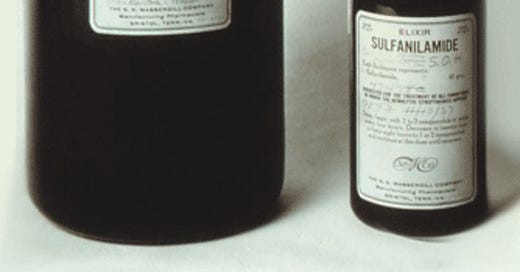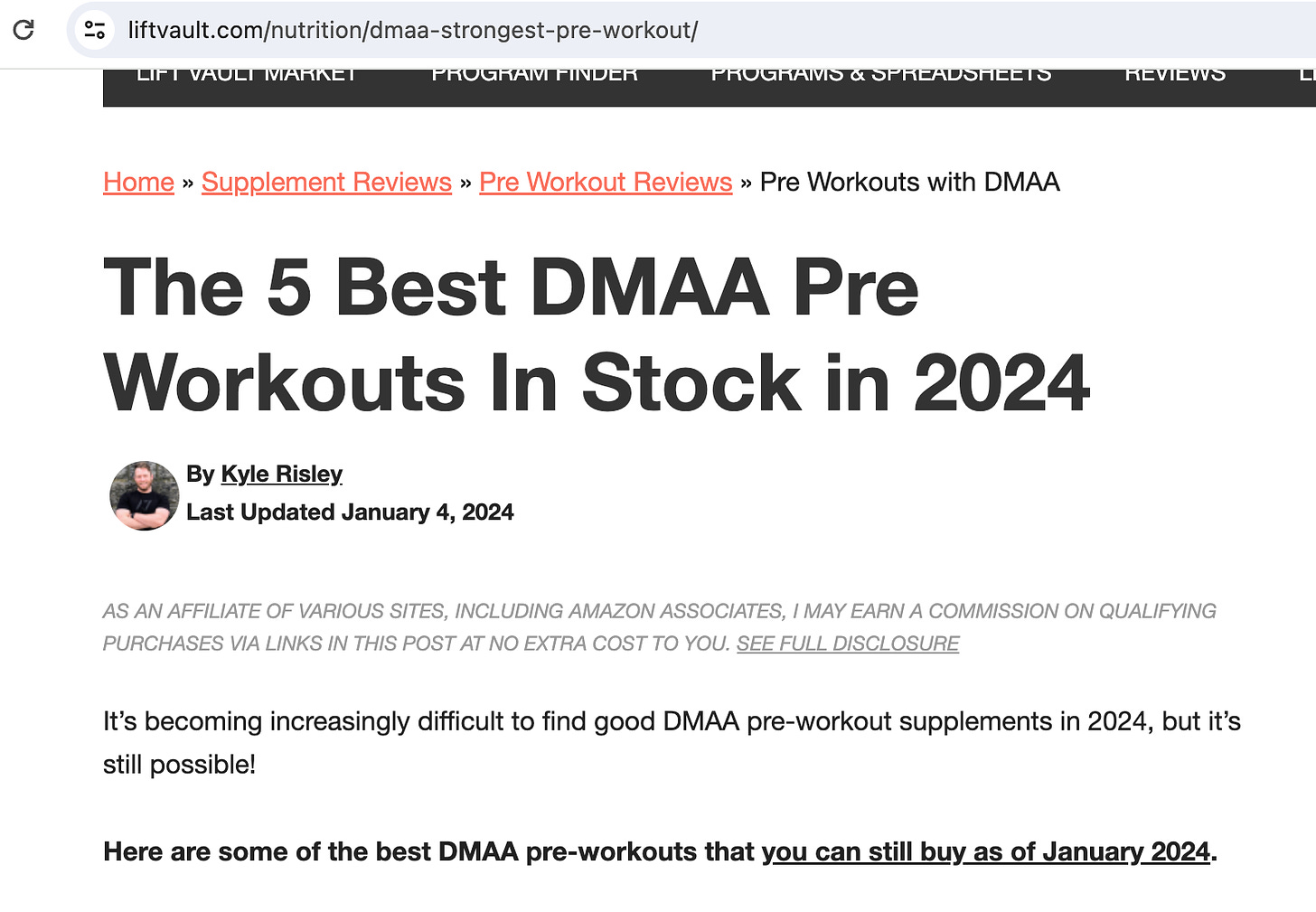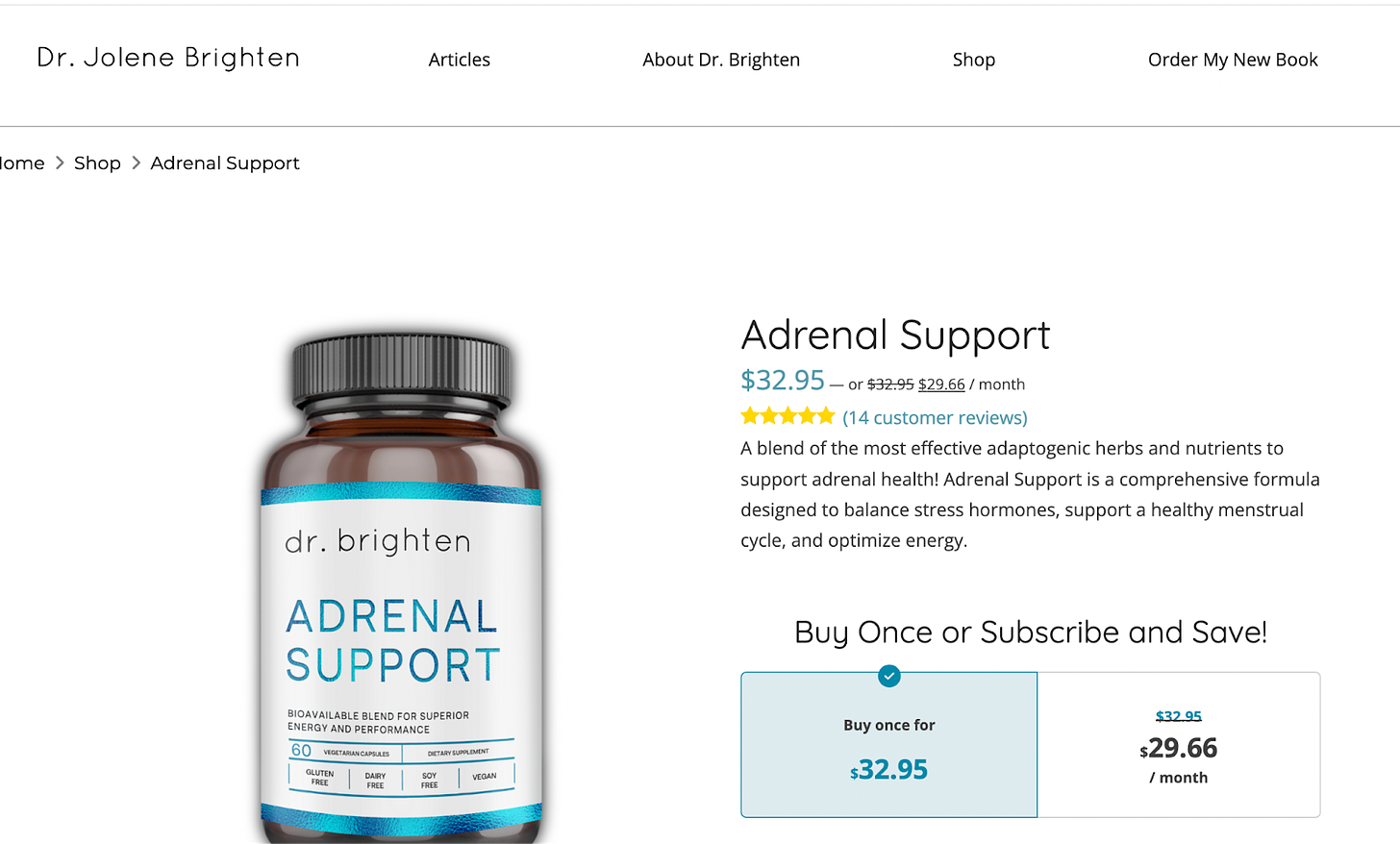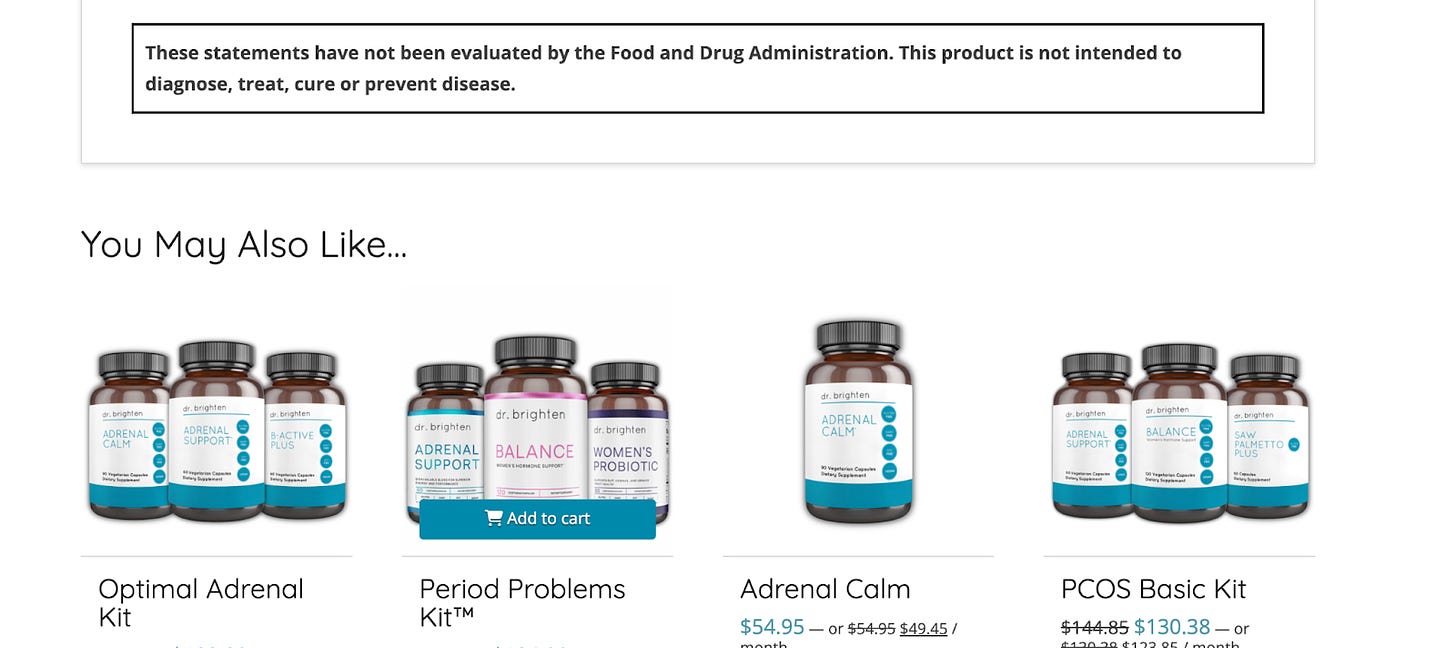I recently asked readers of The Vajenda for some products to debunk (I do love a good thrashing of predatory health claims), and many of you asked about various supplements. That came as no surprise, as questions about supplements are among the most common reasons people send me direct messages or tag me on Instagram.
I understand the interest and the questions; after all, supplements are advertised seemingly everywhere, and if you have looked at any health content on social media, I am sure they are fed to you daily (hourly?). But how can they be everywhere and also be useless? And they are sold by many medical professionals, researchers, and influencers. People we trust. How can they all be wrong?
To counteract this supplement-a-palooza, I am starting a series on supplements, where I will look at the claims, the evidence (such as it is), and the profit. But before we get to specific products, I want to review the backstory about how supplements became such a shit show in the United States. (There is no other way to describe a capitalist venture with zero regulation that has killed people and ruined lives).
The Shit Show Before the Shit Show
Adulterated and contaminated foods were all too common in the 1800s. If a cherry wasn’t red enough, add dye to the bottle, and if it’s toxic, who cares? Need a medication that makes people feel better? Add fortified wine. Want to dye your lashes? Who cares if the active ingredient causes blindness? And yes, these are all real examples.
Then, in 1906, in an attempt to protect the American public, The Pure Food and Drug Act was passed, requiring accurate labeling and that additional, potentially harmful ingredients be listed. While an important step, many dangerous over-the-counter cosmetics and medications remained, including Radithor, radioactive water (no, really), and Koremlu, a permanent hair-removing cream that contained thallium acetate (a rat poison that has since been banned due to its extreme toxicity to humans). Even when applied to the upper lip, the result could be hair loss all over the body, paralysis, and damaged vision. Yes, known poisons were on the market disguised as helpful remedies, people suffered, and the government had little recourse.
A bill was introduced in the early 1930s to create more regulation, which was sorely needed, but it went nowhere until, sadly, in 1937, a predictable tragedy struck. S.E. Massengill Co., in response to the demand for a liquid form of an antibiotic, sulfanilamide, created Elixir Sulfanilamide, primarily intended for children. The problem was the solvent, diethylene glycol, is highly toxic (it’s in antifreeze). Over 100 people in 15 states, many of whom were children, died. The Food and Drug Administration launched a massive cross-country investigation to track every ounce sold. It was awful because the company initially sent telegrams to pharmacies just stating there was a recall, omitting the key information that the medication was a poison that could be fatal even in very small amounts, so there was little urgency with the recall.
Here’s a quote from the FDA commissioner at the time, Walter Campbell, pleading for more regulation:
"These unfortunate occurrences may be expected to continue because new and relatively untried drug preparations are being manufactured almost daily at the whim of the individual manufacturer and the damage to public health cannot accurately be estimated. The only remedy for such a situation is the enactment by Congress of an adequate and comprehensive national Food and Drugs Act, which will require that all medicines placed upon the market shall be safe to use under the directions for use. ..."
Honestly, when you consider that supplements are a leading cause of liver damage, Ayurvedic medicines are routinely contaminated with lead, and many supplements contain medications banned by the FDA, that quote from 1937 is sadly still on the nose today.
Spurred on by the public outcry over Elixir Sulfanilamide, the 1938 Food, Drug, and Cosmetic Act was passed into law. The law required manufacturers to prove the drugs were safe and effective, prohibited false claims about efficacy, and legislated factory inspections. This is also where homeopathic remedies found their way into a sort of no-man’s land of medication. Senator Royal Copeland, a physician who became a homeopath, added homeopathic remedies in such a way that essentially excluded them from proof of efficacy as they had already “met” safety standards.
Laws work for a while but must be updated or rewritten as beliefs change, new technology brings new products, and people find ways around the law. The 1960s and 1970s saw an explosion of the “natural” movement; health food stores began popping up everywhere, and vitamins, food additives, herbal products, and other remedies flooded the market. It became clear that more regulation was needed, but governments are rarely proactive regarding health; rather, they are reactive regarding tragedy. In 1989, another preventable mass poisoning occurred when over 1,500 people were affected by eosinophilia myalgia due to supplements containing L-tryptophan, and thirty-eight died. The exact source was never identified but was hypothesized to be a contaminant created or introduced during manufacturing. L-tryptophan products were removed from the market, and the illnesses stopped. This event spurred renewed interest in increasing regulation. In 1991, the FDA started implementing regulations to protect consumers and hold these companies to safety and advertising standards.
The Dietary Supplement Health and Education Act of 1994
Not surprisingly, the industry pushed back. Legal battles ensued. Senator Orin Hatch, a Republican from Utah, stepped in and crafted a bill to let supplement companies essentially do whatever they wanted with the Dietary Supplement Health and Education Act of 1994, or DSHEA. Hatch was from Utah, a haven for supplements and multilevel marketing, which earned it the nickname “cellulose valley.” Hatch was apparently a personal believer in supplements. Although the cynic in me thinks if supplement companies are among your biggest donors and your son is a lobbyist for a supplement company, you might develop a public taste for them. Apparently, Hatch displayed supplements in his office. Before Hatch stepped in, supplements in the United States were a $9 billion-a-year business; now it’s $50 billion.
Hatch removed all regulations, not just for vitamins and minerals (think vitamin B12 or iron, things people might actually need to supplement their diets), but herbs, botanicals, amino acids…you name it. As long as the product doesn't make a specific medical claim, for example, ‘“treats yeast infections,” and somewhere, even in the tiniest print, has the get-out-of-jail free card statement, “These statements have not been evaluated by the Food and Drug Administration. This product is not intended to diagnose, treat, cure, or prevent any disease,” the product can literally be dirt scooped up from someone’s backyard, and it is perfectly legal.
So yes, someone could remake Elixir Sulfanilamide and sell it because the American government doesn’t require any safety testing or proof the product contains what it claims. And lest you think the idea of antifreeze in supplements is absurd today, in late 2023, the FDA warned that multiple supplements labeled as tejocote (Crataegus mexicana) root were really yellow oleander (Cascabela thevetia), a poisonous plant that can kill even with very small doses. Nine of the ten products tested contained yellow oleander. Let’s say that one more time, 90% of products tested were poison. The investigation and subsequent warning to the public was the result of a toddler ingesting some of the product and ending up in the emergency room with heart problems.
Here’s the real kicker. Products labeled as tejocote have been known since at least 2021 to contain the poisonous yellow oleander, and there have already been several reports of serious cardiac complications from ingesting products labeled as tejocote.
In any other industry (other than gun manufacturing), if a known poison/manufacturing flaw that puts lives at risk had been identified, something would have happened. For example, all Boeing 737 Max 900 planes were grounded after part of the fuselage blew out of one at 16,000 feet. But it’s a supplement, so maybe the FDA sends a warning letter to the manufacturer. That lacks the negative PR punch of a plane grounding and is certainly not very scary for a multimillion-dollar product.
(And for my Canadian friends, don’t think things are much better. Even though supplements must be licensed by Health Canada, which means they have been “found to be safe, effective and of high quality,” Health Canada does no testing and relies on the word of the manufacturer.)
Once in a while, if an outcome is especially tragic, the FDA will sue a manufacturer or even file criminal charges. For example, two former dietary supplement company executives were sent to prison, and two companies paid over $10 million in fines over the fraudulent and dangerous Jack3d and OxyElite Pro supplements. Two U.S. Army soldiers died after taking Jack3, which contains the stimulant dimethylamylamine or DMAA, which is an amphetamine. DMAA was banned in 2013 but is still widely available. In fact, some guy at the website “Lift Vault” is only too happy to tell you where you can get it.
According to Kyle, the “real” reason it’s hard to get DMAA isn’t that it killed two people and is illegal in the United States, but that it’s the result of a “rocky relationship the FDA and other regulatory agencies have with DMAA and DMHA.”
Killing two people and illegal…rocky relationship. It’s the same thing, right?
Adulteration of supplements with active pharmaceuticals is common. Some of these pharmaceuticals are dangerous because the compound is dangerous, like DMAA, and sometimes, they are contaminated with approved pharmaceuticals. I’ve written previously about a study of “sports enhancers,” and 12% contained an ingredient banned by the Food and Drug Administration (FDA). One supplement contained four banned ingredients, and one even contained a substance that has never been approved for human use anywhere. Even if the added pharmaceutical isn't itself dangerous, there is a risk of negative medication interactions that can’t be predicted. And of course, not every person can safely take every pharmaceutical. Supplements for weight loss, metabolism boosters, muscle building, and libido seem to be the most common ones that are adulterated with pharmaceuticals. Still, of course, you never know because the system is designed, so you can’t know. A supplement for hot flashes could contain estrogen, so it may actually work, but then you are taking estrogen, and you don’t know how much. Could you get a blood clot? What about endometrial cancer? Real possibilities for harm.
Don’t Forget the Dangerous Microbials
As there is no enforcement of good manufacturing practices, contamination of products by harmful bacteria, mold, and yeast is a real concern (echos of L-tryptophan, which is now back on the market, by the way, and there has since been a case report of eosinophilia myalgia). A study by V.H. Tournas looked at 183 dietary supplements, and “Potentially toxigenic molds were found in alfalfa, coriander, echinacea, garlic, ginkgo, juniper, licorice, psyllium and St. John's wort supplements.” Products containing kratom have been contaminated with Salmonella, resulting in 50 people needing hospitalization, and probiotics have been linked with liver abscesses. Contamination with microorganisms is a concern for everyone, but especially risky to immunosuppressed people.
Then there is Heavy Metal Contamination…
Studies tell us that 20% of Ayurvedic products are contaminated with lead. Really, 20%. If 20% of chickpeas were contaminated with lead, chickpeas would be banned, and the story would be on the front page above the fold of every newspaper. But it’s a supplement, so have at it. A study from Canada showed that of 121 supplements tested, 5% exceeded the safe level of arsenic, and 1.7% exceeded the levels for lead, cadmium, and aluminum. In many studies, there are heavy metals, although not enough in an individual product to be a concern. However, considering many people take more than one supplement, the possibility of tipping over into concerning exposure is very real.
It’s Also About a Lack of Efficacy
As a consumer of supplements, you incur all the risks of potentially adulterated products, whether black or gray-market pharmaceuticals, dangerous additives, heavy metal contamination, or microbial contamination. But the other issue with supplements is that you are incurring all of these potential risks with little to no proof they do what they claim in the first place as supporting studies, when they even exist, are often of low quality and/or found in predatory journals. Some papers are funded by the company involved and appear designed as part of a marketing strategy to get several low-quality studies in the literature to make it look like the supplement is a “thing.” When the data in these papers is reviewed by independent researchers, they can’t find much, if any, data to support the supplement's efficacy. For example, the Menopause Society recently reviewed multiple supplements for hot flashes, and not one had good enough evidence to recommend. Kind of makes you wonder what the supplement companies are doing with those $50 billion dollars a year because they sure aren’t using it to test their products in a scientifically rigorous way.
Beware of Advice from Those who Sell and Profit from Supplements
Supplements are so lucrative it’s actually painful. Thinking back to the DMAA disaster, one manufacturer, USPLabs, initially refused to destroy or turn over their stock to the FDA. When the FDA was ultimately successful, the amount destroyed was worth more than $8 million on the market. That’s one product line from one company. It’s easy to see why supplements are so appealing, business-wise.
So, the first thing I do when someone asks me about medical information from a source, whether they are a medical professional, researcher, of influencer, is Google their name, looking for their connection with supplements. If they have their own line of supplements or do ads for them, I have zero interest in what they have to say about anything, and yes, that includes Andrew Huberman, PhD, Jolene Brighten, ND, and Dr. Amen. Why listen to someone, even someone with an MD or a PhD, who profits from untested and unregulated pharmaceuticals when there are many good sources that don’t have the supplement baggage and bias? Do you really want medical information from someone who makes money by selling you a product that is “not intended to diagnose, treat, cure or prevent disease?” If they are so connected to cutting-edge research, shouldn’t they be able to recommend products that actually treat, cure, and prevent disease?
Because supplements can’t be advertised for specific medical conditions, science-adjacent yet medically meaningless terms, such as “support” or “boost,” are used. But your adrenal glands or ovaries or other organs don’t need “support.” There is no physiology lecture in medical school on “support.” This language is a bait-and-switch to make a product sound medical and “natural” when it is untested and unregulated.
But hey, if the support doesn’t work, maybe your adrenal glands need calming for $54.95 a month, $49.45 with a subscription.
If I sold a birth control pill in an online store that I profited from, you should and would rightly call me out for it. You would rightly be distrustful of my advice for contraception or treating abnormal bleeding. You should keep that same thought in your mind for all these people selling supplements. Profit creates bias. But at least if I sold a birth control pill, you’d know it didn’t have mold or a designer steroid that hasn’t been tested on humans, and you would know the efficacy and the rate of complications.
Supplements are Untested, Unregulated Pharmaceuticals
There is no greater example of buyer-beware in medicine than supplements. Literally, no one is looking out for you. I do not believe there is any other industry in the United States with such potential for harm that is this unregulated (with the exception of guns). Drop-down cribs killed 32 infants over nine years and were rightly banned.
From time to time, I will review specific supplements, and next up in this series, I will review some of the recommended vitamins and minerals. Along the way I will also review products for hot flashes and the nebulous “hormone support” category, mostly as an exercise in how to evaluate these products and find the reg flags. And let me know if you have specific products you want me to review.
Now you know why I have such disdain for supplements and those who sell them. You have a right to know what you are putting in your body, and you have a right to know if that product can do anything meaningful for you health-wise. Ok, you only have that right for medications in the United States. Buying a supplement is like buying gas from a guy selling it out of a can on the side of the road; all you can do is hope that it’s actually gasoline and not something that could wreck your engine or cause your car to blow up.
References
The 1906 Food and Drugs Act and Its Enforcement https://www.fda.gov/about-fda/changes-science-law-and-regulatory-authorities/part-i-1906-food-and-drugs-act-and-its-enforcement
Ballentine C. Sulfanimamide Disaster. FDA Consumer Magazine, June 1981 https://www.fda.gov/files/about%20fda/published/The-Sulfanilamide-Disaster.pdf
1938 Food, Drug, Cosmetic Act https://www.fda.gov/about-fda/changes-science-law-and-regulatory-authorities/part-ii-1938-food-drug-cosmetic-act
Pray WS. Orrin Hatch and the Dietary Supplement Health and Education Act: Pandora’s Box Revisited. Journal of Child Neurology. 2012;27(5):561-563. doi:10.1177/0883073812441064
Podolsky SH, Kesselheim AS. Regulating Homeopathic Products — A Century of Dilute Interest
N Engl J Med 2016; 374:201-203
Swygert LA, Back EE, Auerbach SB, Sewell LE, Falk H. Eosinophilia-myalgia syndrome: mortality data from the US national surveillance system. J Rheumatol. 1993;20:1711–17.
Eosinophilia-myalgia syndrome and L-tryptophan-containing products--New Mexico, Minnesota, Oregon, and New York, 1989. Centers for Disease Control (CDC) MMWR Morb Mortal Wkly Rep. 1989;38:785–8.
Allen JA, Peterson A, Sufit R, Hinchcliff ME, Mahoney JM, Wood TA, Miller FW, Whitfield ML, Varga J. Post-epidemic eosinophilia-myalgia syndrome associated with L-tryptophan. Arthritis Rheum. 2011 Nov;63(11):3633-9. doi: 10.1002/art.30514.
Belongia EA, Hedberg CW, Gleich GJ, White KE, Mayeno AN, Loegering DA, Dunnette SL, Pirie PL, MacDonald KL, Osterholm MT. An investigation of the cause of the eosinophilia-myalgia syndrome associated with tryptophan use. N Engl J Med. 1990 Aug 9;323(6):357-65.
Hiltzik M. Orin Hatch is Leaving the Senate, but his Deadliest Law Will Live On. LA Times Accessed 01/17/24 https://www.latimes.com/business/hiltzik/la-fi-hiltzik-hatch-20180105-story.html
Shin D, Kang HS, Park EM, Kim J, Kwon J, Suh J, Moon G. Authentication of tejocote (Crataegus mexicana) dietary supplements based on DNA barcoding and chemical profiling. Food Addit Contam Part A Chem Anal Control Expo Risk Assess. 2021 Dec;38(12):1985-1994.
Berland N, Kababick J, Santos C, Calello DP. Notes from the Field: Online Weight Loss Supplements Labeled as Tejocote (Crataegus mexicana) Root, Substituted with Yellow Oleander (Cascabela thevetia) - United States, 2022. MMWR Morb Mortal Wkly Rep. 2023 Sep 15;72(37):1016-1017.
White CM. Dietary Supplements Pose Real Dangers to Patients. Annals of Pharmacotherapy. 2020;54(8):815-819. doi:10.1177/1060028019900504
Tournas VH. Microbial contamination of select dietary supplements. J Food Safe 2009;29:430-442.
Genuis SJ, Schwalfenberg G, Siy AK, Rodushkin I. Toxic element contamination of natural health products and pharmaceutical preparations. PLoS One. 2012;7:e49676.
Us Department of Justice, Press Release. Two Individuals And Two Companies Sentenced In Scheme To Fraudulently Sell Popular Dietary Supplements. https://www.justice.gov/opa/pr/two-individuals-and-two-companies-sentenced-scheme-fraudulently-sell-popular-dietary







